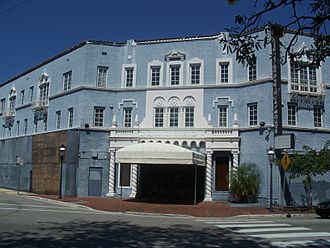Coconut Grove Playhouse facts for kids
Quick facts for kids The Coconut Grove Playhouse |
|
|---|---|

Coconut Grove Playhouse
|
|
| General information | |
| Type | Theatre |
| Location | Coconut Grove, Miami, Florida |
| Coordinates | 25°43′32″N 80°14′41″W / 25.7255°N 80.244731°W |
| Inaugurated | 3 January 1927 |
| Design and construction | |
| Architecture firm | Kiehnel and Elliott |
| Main contractor | Albert Peacock |
The Coconut Grove Playhouse was a famous theatre in the Coconut Grove area of Miami, Florida. It first opened its doors on January 3, 1927. Back then, it was a movie theatre called the Player's State Theater.
This building was special for a few reasons. It was one of the first movie theatres on Florida's east coast to have air conditioning. It also had the largest Wurlitzer organ in the entire United States. The theatre was used for many different kinds of shows. It closed in 2006 and has not been used since. In 2018, it was added to the National Register of Historic Places. This means it's an important historical building.
Contents
History of the Playhouse
In the 1950s, a man named George Engle bought the theatre. He spent a lot of money to change it into a place for live plays. An architect named Alfred Browning Parker helped with these changes.
The theatre reopened on January 3, 1956. The first show was a famous play called Waiting for Godot. Many well-known actors performed there over the next fifty years. These included Liza Minnelli, Bea Arthur, and George C. Scott.
Local Actors Take the Stage
From 1964 to 1965, a group called The Miami Actors Company used the Playhouse. This group was started by Ilse Earl, a theatre teacher at Miami Dade College. Only 20 actors from the Miami area were chosen to join. They performed plays like J.B. and All the Way Home.
New Artistic Leaders
In 1982, a famous actor and director named José Ferrer became the Artistic Director. Under his leadership, the Playhouse became one of the best theatres in the country. Later, Arnold Mittelman took over this role in 1985.
Many plays that started at the Coconut Grove Playhouse later moved to Broadway. These included Neil Simon’s The Sunshine Boys and Urban Cowboy. The theatre also showed the very first performance of Fame: The Musical. This musical later became a big hit in London. The Playhouse now has two stages. There is a large 1700-seat Mainstage Theater and a smaller 100-seat Encore Room Theater.
Programs for Young People
The Playhouse offered many programs for people of all ages.
- In-School Touring Program: This program brought plays to students in grades six through twelve.
- Lizard Lessons: These were original plays with music for younger kids, from kindergarten to third grade.
- Summer Theater Camp: A camp for teens to learn about theatre.
- Theater Stages: This program taught acting, playwriting, costume design, and improvisation. It was for children, teens, and adults.
Other Special Events
The Coconut Grove Playhouse was also used for other events. On November 22, 1996, the Late Show with David Letterman was filmed there. It was the last time the show was filmed outside of New York City.
Closing and Future Plans
The Coconut Grove Playhouse closed in 2006. This happened because it cost a lot of money to run the large theatre. It has stayed closed since then.
In 2014, Miami-Dade County was allowed to take over the building. There are now plans to bring the theatre back to life.
Ideas for the Theatre's Future
The current plan is to build a 300-seat theatre inside the building. A theatre company called GableStage would run it. They would work with Florida International University to give students real-world experience. The City of Miami also agreed to remove $1.5 million in old building fees.
Another idea was to create a larger 700-seat theatre. This plan was supported by Mike Eidson, who works with the Adrienne Arsht Center. There was even talk that actor Kevin Spacey might help as an advisor. This larger plan has not been approved yet, but it is still being considered.
Some people think a 700-seat theatre is too big. They worry it would be hard to fill, especially with other large theatres nearby. However, many others support the idea. They hope a bigger theatre could bring in famous stars and make the Playhouse a top theatre again.
Restoring the Historic Building
Miami-Dade County has chosen a company called Arquitectonica to restore the Playhouse. They will make sure the building meets modern safety rules. $20 million has been set aside for this work.
Because the building is a historical landmark, it cannot be completely torn down. Many people want to make sure that most of the original building is saved. An architect named Richard Heisenbottle has drawn plans that could fit both the 300-seat and 700-seat theatre ideas. These plans would also keep most of the original outside look of the building.
Images for kids


